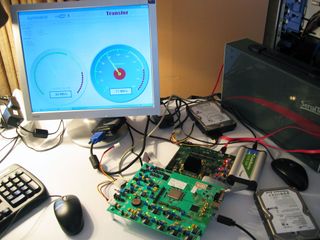CES '09: Morsels From Our Meetings

Introduction
Bright lights, exotic cars, and minimal clothing in the middle of January—at first blush, CES has all the makings of a really good time.

Okay, who are we kidding? After-hours, it really is. But between 8:00 AM and somewhere around 6:00 or 7:00 PM, the show is all business. The world’s most popular consumer electronics and technology vendors showed up to demonstrate the wares that’ll see them through this tough economic climate—though attendance was down from years past as we heard exhibitors chatter about empty booths and Las Vegas Convention Center walls that had been deliberately brought in to maintain the illusion of density.
Nevertheless, there was plenty to see. So much so, in fact, that I personally never got a chance to actually peruse the show floor. It was wall-to-wall meetings from the 7th until the 10th, when most of the exhibitors we talked to were planning on packing their things. Unfortunately, that meant skipping North Hall altogether and stepping into Central Hall just long enough to get the low-down on Windows 7 and Intel’s plans for the rest of 2009. South Hall got a bit more foot traffic, but only so far as it meant finding certain booths.
Fortunately, we still came away with a good sense of how the rest of the year could play out. We overheard plenty of conversations that underscored the dire straits a number of companies are really in (XM and Sirius employees not at all happy about that merger, for example). And we saw tons of products that tried ducking in under the power-friendly/budget-friendly banner as a sign of the times.
USB 3.0: A Preview Of Things To Come
One of our first meetings was with the folks at Symwave, who were demonstrating early PHY technology supporting the USB 3.0 specification. We’ve already written a bit about USB 3.0, but in short, it’s a 5 Gb/s serial interface with the same 8b/10b line code as USB 2.0 (and consequential 20% overhead, pulling the theoretical cap down to 4 Gb/s).
Of course, with peak throughput in the 500 MB/s range, host-based processor utilization becomes a significant concern, especially considering the relative inefficiency of USB 2.0’s polling mechanism, which involves the host every time a transaction takes place. With USB 3.0, the device initiates and terminates the communication, but does not have to be involved in every packet transaction. USB 3.0 is also point-to-point topology—similar to FireWire—and not a broadcast topology.
Stay on the Cutting Edge
Join the experts who read Tom's Hardware for the inside track on enthusiast PC tech news — and have for over 25 years. We'll send breaking news and in-depth reviews of CPUs, GPUs, AI, maker hardware and more straight to your inbox.

This means you’re going to see better power management. I have a USB 2.0 hub sitting on my desk, communicating with my keyboard, Bluetooth PAN, HDD cradle, and printer. As a result of USB 2.0’s topology, one device broadcasting keeps all of the others powered up. But with USB 3.0, the hub (providing it’s a 3.0 hub), knows which device is active and can power down the others.
-
neiroatopelcc So a new socket is planned for mainstream core i7 systems? If that's the case, why even invest in an x58 in the first place?Reply -
squatchman Reading hard!Reply
"Core i7 variant later this year with on-chip graphics, a different socket interface, and two channels of DDR3 memory support. "
It sounds like a crippled version of i7. Dual channel memory that takes DDR3 and some weak IGP? No thank you. -
enewmen At about that time, the socket LGA-1366 and LGA-1567 will be moving to server space while the LGA-1156 is for Desktop platforms. The good news is the Desktop platform when Sandy Bridge is released should be a lot faster for apps like games, recoding, etc. While the server platform will be better for databases, VMs, and other high-IO applications. I don't know yet if Sandy Bridge will be LGA-1156 or 1366, but I guess 1156.Reply
.001 cents worth. Lots of info on the web. -
cangelini squatchmanReading hard!"Core i7 variant later this year with on-chip graphics, a different socket interface, and two channels of DDR3 memory support. "It sounds like a crippled version of i7. Dual channel memory that takes DDR3 and some weak IGP? No thank you.Reply
It's all about getting that architecture into the mainstream though, right. For as well as it performs, i7 is still an expensive proposition. -
JonnyDough Too expensive. Which is why Phenom II seems to be picking up a bit of steam. Intel always seems to have issues with socket changes.Reply -
TwoDigital Reading through multiple web sites (including Intel's 2009 roadmap presentations) the socket 1366 is being targeted at 'enthusiast' users. They are also releasing a socket 1567 server connect (replacing the current Xeon socketj 771) and an entry-level socket 1160.Reply
Rumor has it the 1160 will retain the dual-channel memory controller system. The current i7s are based on LGA 1366 and the high-end motherboards I would expect to stay that way for the foreseeable future.
Most Popular


